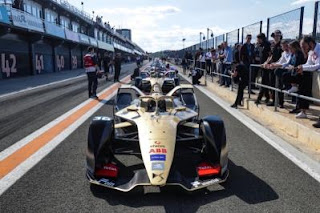 |
| This 1970 DB6 MkII Volante is the first vintage to get a battery pack in place of the engine. |
Aston Martin Lagonda announced a plan to future-proof increasingly valuable collectible cars with a “reversible” EV powertrain conversion, while VW is making its last generation of internal combustion engines.
Bloomberg quoted Michael Jost, strategy chief for Volkswagen group, who said at an industry conference in Wolfsburg, Germany that VW’s engineers “are working on the last platform for
vehicles that aren’t CO2 neutral”.
“We’re gradually fading out combustion engines to the absolute minimum,” Jost said.
VW is the world’s largest automaker with 12 automotive brands in its stable — from bikes to trucks — and the group has already introduced several electric cars, from the VW Golf to the 2019 Porsche Taycan.
 |
| 22 cars will line up for the Electric Formula races starting on December 15. |
Aston Martin Lagonda is not looking forward with its plans, but backwards in to save old cars using cassettes.
Only, these cassettes are flat battery packs and electric motors that is fitted in place of the old fossil fuel engine.
Aston Martin claims it is a first, but Mahindra has been converting its cars for frugal drivers in India, while Aston Martin Lagonda plans to do it for well-heeled buyers of collectible cars, starting with a 1970 DB6 MkII Volante, which was originally hand-built at Newport Pagnell.
 |
| Rivian's R1T pick-up shows there is a lot of space under the hood if you use 'lectric. |
Aston Martin said in a statement: “Given the historical significance of these collectors cars it’s vital any EV conversion is sympathetic to the integrity of the original car.
“The cassette system offers the perfect solution, offering owners the reassurance of knowing their car is future-proofed and socially responsible, yet still an authentic Aston Martin with the ability to reinstate its original powertrain if desired.
Andy Palmer, Aston Martin Lagonda President and Group Chief Executive Officer, said of the Heritage EV concept: “We are very aware of the environmental and social pressures that threaten to restrict the use of classic cars in the years to come.
 |
| A Lexus V8 four cam 32 mate, thaaaat's the one, say these mechanics. |
At the local Vintage Sports Cars Club, the response to advent of quietly humming electric motors instead of the roar of a straight six were met with with scorn.
 |
| Mike Smith prefers to fiddle with fossil fuel drivetrains than to hum along to electric motors. |
Having built with Jens Denks the world’s first, only and thus fastest all-wheel drive electric-fuel hybrid Atos; and as rider of an electric scooter, I had to differ.
“One gets a very wide grin each time you pass the fuel pumps in an evee,” I told Smith.